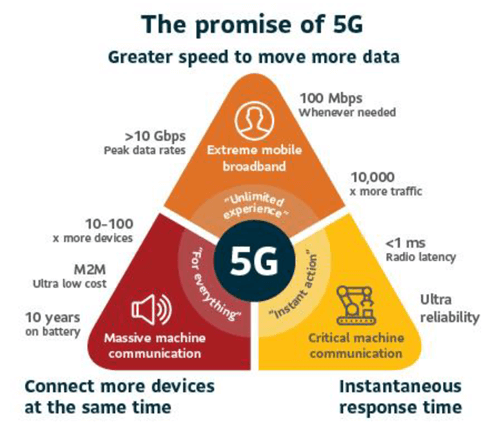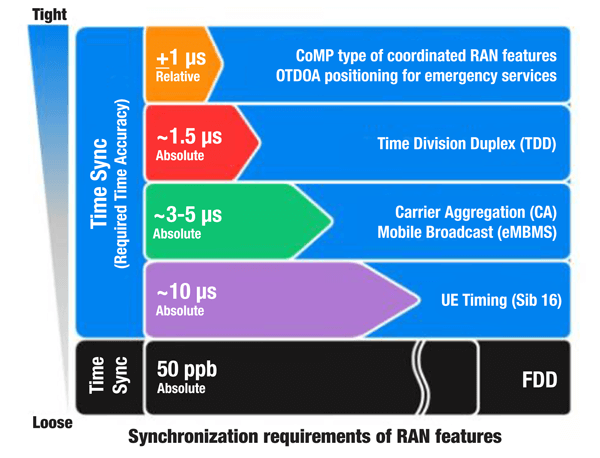TechnologyMay 18, 2025
5G implementation of a CIP motion network

Use of the wireless medium in motion applications requires some ability for the applications to be time-sensitive below 250 microseconds. Findings suggest C2D and D2D (Sidelink) 5G applications are easy to implement and offer a robust toolkit for wireless CIP Motion.
Use of the wireless medium in more deterministic applications, more generally known as motion applications, requires some ability to be time sensitive to below 250 microseconds. This article examines the tools available to enable time synchronization and how they relate to CIP Motion. Investigations into adding Time synchronization to the hardware infrastructure found the latency on 5G is relatively closed loop motion control, which would not require infrastructure time synchronization, only peer to peer.
Using Precision time protocol in C2C (Controller to Controller), D2D (Device to Device), D2C (Device to Controller) and C2D (Controller to Device) theoretical applications, D2C and C2D applications where deemed the most feasible. In the applications Closed Loop Motion control was the dominant solution for time synchronization.
Our findings suggest C2D and D2D (Sidelink) 5G applications are easy to use and offer a robust toolkit for wireless CIP Motion.
A broader medium for motion protocols

Figure 1: 5G market capabilities.
For decades, the wireless medium has been seen as the medium of the future in all things communication. From commercial, to retail, and now to industrial, wireless communication seemingly solves many problems at once, from cable maintenance, to bends to use of multiple protocols under the abstraction layers, its connectivity and dis connectivity are ubiquitous and unseen.
These revolutionary appeals are seen throughout our commercial and personal spaces, with around 147-158 Million wireless routers sold annually Yet the industrial market space has not seen the ROI in wireless as the commercial space has, evidence for this, such as limited adoption (5% of all factories)[security concerns and limited growth (9% per year) although tertiary, is significant, although most industrial spaces double as an IT space, with wireless routers connecting many IT centric products, we have yet to see the exponential growth in this space, with an average 25% growth rate in the industrial market and 9% Year over Year Growth.
With new types of wireless protocols, such as wireless HART, Bluetooth LE, and 5G now being analyzed for the industrial world, perhaps these new avenues may push the industrial application ecosystem for adoption.
…and a more narrow one
Although much of the industrial communications ecosystem is varied, much has been done, particularly with the 5G ACIA group, to identify and agglomerate the types of industrial communication based on application. In their working paper “Key 5G Use Cases and Requirements” real time, or RT use cases are well defined and targeted for specific applications.
Non-RT: Cycle times and latency are not critical; several seconds are regarded as sufficient Soft RT: Cycle times and latency are moderately critical, i.e. approximately one second
Hard RT: Cycle times and latency are highly critical, to within milliseconds or even microseconds
As Wi-Fi and Bluetooth have evolved to allow themselves into the industrial ecosystem, many of the Non-RT, and some soft RT types of applications have grown in their wireless uses. There continue to be many Non-RT and Soft RT solutions that continue to use cables for various reasons but it is not within the prevue of this article.
Inevitably, both Wi-Fi and Bluetooth have struggled to be applied to the Hard RT applications on the factory floor. This is mainly due to cycle with these technologies. Hard RT applications require millisecond, and in some applications, like motion, sub millisecond cycle time, also called network latency.
| Use Case | Category | |
|---|---|---|
| 1 | Connectivity for the Factory Floor | Hard RT |
| 2 | Seamless integration of wired and wireless components for motion control | Hard RT |
| 3 | Local control-to-control communication | Hard RT |
| 4 | Remote control-to-control communication | Soft RT |
| 5 | Mobile robots and AGVs | Soft RT |
| 6 | Closed loop control for process automation | Soft RT |
| 7 | Remote monitoring for process automation | Non-RT |
Built for latency, finally.
As wireless technology has evolved, cellular companies and organizations have seen themselves as the next generation of wireless technology. Cellular technology has evolved dramatically compared to wireless and Bluetooth. If measured in specification length, the 5G specification is a compendium of all cellular technologies, and around 100 times larger in page length compared to Wi-Fi 7 and Bluetooth LE.

Figure 1. Example workflow for Secure by Default with EtherNet/IP Pull Model Profile
Cellular technology was first used as a replacement for phone cabling, mostly at government facilities. As well ports, mines and other large, networked areas have been using cellular technology on their industrial networks for quite some time. However, with the advent of 5G as a 3GPP specification, groups such as the 5G ACIA, and various companies have lobbied to enable this complex technology to add functionality to tackle these highly deterministic protocols. During some of 5G first releases, case studies were produced to showcase the ability to use 5G, specifically its dedicated channels, to significantly lower the operational threshold for applications.
Initial discussions and case studies during 2017 3GPP meeting showcased some IEEE 1588 and TSN variant possibly being used as a medium to carry highly deterministic data. This case studies matured over release 15 into the penultimate standard in release 17. Release 17 built the ecosystem for which deterministic systems, as applied in the marketed role out of “instant action” of ultra reliability and <1 ms radio latency.
Release 17 pointedly added IEEE 1588 PTP support, not just IEEE 802.1AS gPTP. This included support for Boundary Clocks, Peer to Peer & peer to peer transparent clocks, and more.
Now, to support the 1588 specification, is one thing, the next question is how to use it. The more abstract the use, the more difficult it is to set up in an application, and the less likely it will be adopted to the market ecosystem. Other types of Deterministic communications protocols are also looking at looking for methodologies to use the 5G protocol to lower integration times, higher scalability, and promote new, more wireless centric markets, such as ports and Mining.
CIP Motion and 5G
As has been previously demonstrated, EtherNet/IP can be run on 5G, due to the TCP and UDP protocol running in abstraction, the same as most applications, such as web browsers. However, CIP Motion is a special case.
5G base stations all have accurate time synchronization, due to two control plane variables and PTP grandmaster clock support . By mandatory requirements, this synchronization time is 1.5 µs, well below the latency time needed for most CIP Motion systems. The Figure 2 shows specific RAN (Radio Access Network) 5G applications.
As well, a Time Event Identifier all the 5G devices are time synchronized to the 5G base stations. The synchronization is needed for the radio communications to work.
We have found use of this Time Sync Variable used on TDD or more requires less effort from the application and engineering support. With a 1.5 µs synchronization time, we can apply this to CIP Motion applications quite easily. Additionally, the coordination time for CoMP, Coordinated Multi-point technology is now used in most infrastructure products.
However, there are other methods. Master clock thru the controller could be seen as a typical method for CIP Motion synchronization. However, this will need two-time domains:
- 5G time synchronized to TEI
- Controller time which can be free running or synchronized to a time reference of choice
Then this clock will be distributed through the 5G network and the 5G time will be used to calculate what in PTP speak is called the residence time. Although the complexity seems minimal, there are some elements of diagnostics and maintenance which would need to be Ericsson has already implemented time synchronization. The feature was called CIP9, now enabled inside of their TSN platform Regardless, this function now provides an information element which gives the time (of day) for the start of the next timeslot.
Other methods include using “Ethernet PDU (Protocol Data Frames)” for time synchronization along with QoS (Quality of Service) Configurations with TSN (1588). The positive aspect of Ethernet PDU’s is the 5G system handled the Ethernet Frames, creating an easy abstraction layer. A good example is the Ethernet PDU is a virtual ethernet cable connecting the user device to the network. However, problem arise when using the TSN time aware scheduler. The time aware scheduler IEEE 802.1Qbv is used to avoid head- of-line blocking on the TSN part of the network. 5G has its own way of eliminating head of line blocking, this adds complexity to an already complex tool. With CIP Motion, this could be done using the simplest Quality of Service Session, however, need for an Ethernet PDU is someone undemonstrated, as the Ethernet PDU enables complex time synchronization, like those which require a time aware scheduler.
Additionally, products with dedicated signals for time synchronization, such as Ethernet PHY (start of Frame) and signals integration with the radio module, would make it possible to connect non-5G enabled products to the 5G network with relative ease. 5G ACIA has included these signals in their working paper, “Exposure of 5G Capabilities for Connected industries and Automation Applications”.
CIP Motion with 5G Sidelink
5G Sidelink is a feature set of release 16 of the 3GPP defined specification. Although much of the Sidelink case studies defined by3GPP are automotive based, the device to device communication aspect could be beneficial to protocol sets such as CIP motion. CIP Motion supports multicast peer-to-peer communications, which allow position and velocity synchronization in drives controlled by multiple distributed controllers.
5G ACIA has done extensive research on this subject, building Case Studies and recommendations to 3GPP on further use of Sidelink for Industrial Applications. CIP Motion, with its use of 1588, makes use of Sidelink much easier, as QoS and various other implementation strategies unnecessary. Further Laboratory tests are required to understand implementation processes to build out use.


